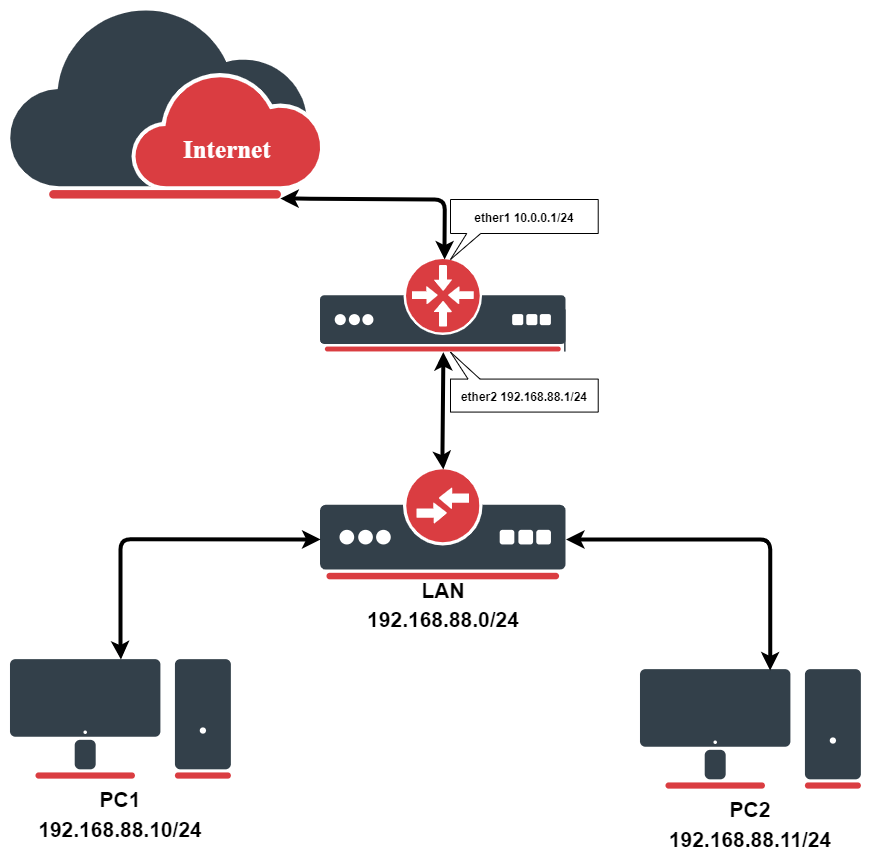Introduction
NAT Port Mapping Protocol (NAT-PMP) is a protocol used for transparent peer-to-peer network connectivity of personal computers and network-enabled intelligent devices or appliances.
Protocol operates by retrieving the external IPv4 address of a NAT gateway, thus allowing a client to make its external IPv4 address and port known to peers who may wish to communicate with it by creating dynamic NAT rules.
NAT-PMP uses UDP port number 5350 - on the client, and 5351 on the server side.
There are two interface types for PMP: internal (the one local clients are connected to) and external (the one the Internet is connected to).A router may only have one active external interface with a 'public' IP address on it
A router can have only one active external interface with a 'public' IP address on it.
For more details on NAT PMP see RFC 6886
NAT-PMP configuration is accessible from /ip nat-pmp menu.
Configuration Example
Let's consider that we already have this basic home setup illustrated above.
Before enabling PMP-NAT we need to masquerade outgoing LAN packets.
/ip firewall nat add action=masquerade chain=srcnat out-interface=ether1
Now we can enable PMP and add internal, external interfaces:
/ip nat-pmp set enable=yes /ip nat-pmp interfaces> add interface=ether1 type=external disabled=no /ip nat-pmp interfaces> add interface=ether2 type=internal disabled=no
When the client from the internal interface side sends PMP request, dynamic NAT rules are created on the router:
[admin@MikroTik] > ip firewall nat print Flags: X - disabled, I - invalid, D - dynamic 0 chain=srcnat action=masquerade out-interface=ether1 1 D ;;; nat-pmp 192.168.88.10: ApplicationX chain=dstnat action=dst-nat to-addresses=192.168.88.10 to-ports=55000 protocol=tcp dst-address=10.0.0.1 in-interface=ether1 dst-port=55000 2 D ;;; nat-pmp 192.168.88.10: ApplicationX chain=dstnat action=dst-nat to-addresses=192.168.88.10 to-ports=55000 protocol=udp dst-address=10.0.0.1 in-interface=ether1 dst-port=55000
Properties
General properties
Available from /ip nat-pmp menu.
| Property | Description |
|---|---|
| enabled (yes | no ; Default: no) | Enable NAT-PMP service |
NAT PMP Interfaces
Available from /ip nat-pmp interfaces menu.
| Property | Description |
|---|---|
| interface (string; Default: ) | Interface name on which PMP will be running on |
| type (external | internal; Default: no) | PMP interface type:
|
| forced-ip (Ip; Default: ) | Allow specifying what public IP to use if the external interface has more than one IP available. |
In more complex setups with VLANs, where the VLAN interface is part of the LAN, for PMP to work properly, the VLAN interface itself should be specified as the internal interface.
